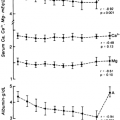CIRCULATING CATECHOLAMINES AND ACTIVITIES OF THE SYMPATHONEURAL AND ADRENOMEDULLARY SYSTEMS
Much of the catecholamine content of human plasma is sulfo-conjugated, especially DA, which is ˜98% conjugated in peripheral blood. Most of DA sulfate production in humans occurs in the gastrointestinal tract.55 Some of the free (i.e., non-conjugated) catecholamines circulate bound loosely to protein. The significance of this protein binding also is unclear.
NE and DA are not hemocrine hormones. That is, the cardiovascular and metabolic effects of these catecholamines require supraphysiologic plasma concentrations. In contrast, even within a physiologic range, circulating EPI can exert circulatory and metabolic effects. Therefore, EPI may be considered to be a hemocrine hormone.
Free and conjugated catecholamines and catecholamine metabolites are excreted in the urine. The renal mechanisms involved are poorly understood. By far the predominant free catecholamine in human urine is DA, and the main catechol is dihydroxyphenylacetic acid.56 The prominence of DA and its metabolites in human urine, in contrast with NE, EPI, and their metabolites, remains unexplained. The measurement of total urinary catechol or catecholamine excretion, therefore, is not as useful a screening test for pheochromocytoma as is the measurement of the excretion of metabolites of NE and EPI.
The urinary excretion of DA in humans exceeds its renal clearance; a proportion of urinary DA must come from DA released by the kidney itself. In humans, most or all of urinary DA is derived from plasma levodopa (L-dopa).56
In the antecubital venous blood of resting, supine, healthy persons, plasma levels of NE average approximately 100 to 400 pg/mL, and those of EPI average ˜5 to 50 pg/mL. Plasma levels of EPI can be less than 5 pg/mL, whereas plasma NE is detectable even in patients with sympathetic failure or those who are undergoing ganglion blockade. Plasma NE increases as a function of age among healthy persons,57 but plasma EPI does not.
Catecholamine concentrations in antecubital venous blood are commonly used to indicate overall sympathetic “tone.”58,59 The validity of this application requires consideration of a few important principles. First, owing to the several removal mechanisms for NE, a large cleft-to-plasma concentration gradient exists, determined primarily by uptake-1.60 Medications or pathologic states associated with inhibition of uptake-1 or overall NE removal may result in overestimation of sympathetic outflow. Second, the vasculature of the arm possesses extensive sympathetic innervation and contributes importantly to NE in the venous drainage. Third, any of several modulators can act presynaptically to enhance or attenuate NE release for a given amount of sympathetic nerve traffic. Last, sympathoneural responses are not always homogeneous among the several vascular beds, so that measuring antecubital venous plasma NE may not detect regional abnormalities in sympathetic outflow.
Stay updated, free articles. Join our Telegram channel

Full access? Get Clinical Tree






